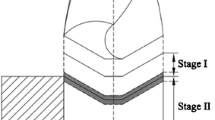Abstract
Drilling is the most commonly applied method for hole making of fiber-reinforced materials owing to the need for structure joining. Delamination is the most common defect during drilling because of the heterogeneity of both the fibers and the matrix. The delamination, in general, is an irregular shape and size, containing long and fine breaks and cracks at the exit of the drilled hole, especially in the drilling of carbon-fiber-reinforced plastic (CFRP). On the other hand, a core–saw drill is designed to reduce the threat of chip removal in drilling composite materials. Since the thrust force of core–saw drill is distributed toward the periphery, the core–saw drill allows a larger critical thrust force than the twist drill at the onset of delamination when drilling composite materials. The aim of this paper is to present a novel approach of the equivalent delamination factor (F ed) to characterize drilling-induced delamination using a core–saw drill and compare it with the adjusted delamination factor (F da) and the conventional delamination factor (F a). The experimental results indicated that the F ed obtained is considered suitable for characterizing delamination at the exit of a hole after drilling CFRP.
Similar content being viewed by others
References
König W, Wulf C, Grass P, Willerscheid H (1985) Machining of fiber reinforced plastics. Ann CIRP 34(2):536–548
Brinksmeier E (1990) Prediction of tool fracture in drilling. Ann CIRP 39:97–100
Hocheng H, Dharan CKH (1990) Delamination during drilling in composite laminates. ASME J Eng Ind 112:236–239
Hocheng H, Tsao CC (2006) Effects of special drill bits on drilling-induced delamination of composite materials. Int J Mach Tools Manuf 46:1403–1416
Tsao CC (2007) Taguchi analysis of drilling quality associated with core drill in drilling of composite material. Int J Adv Manuf Technol 32:877–884
Tsao CC (2008) Comparison between response surface methodology and radial basis function network for core-center drill in drilling composite materials. Int J Adv Manuf Technol 37:1061–1068
Abrão AM, Rubio JC, Faria PE, Davim JP (2008) The effect of cutting tool geometry on thrust force and delamination when drilling glass fibre reinforced plastic composite. Mater Des 29(2):508–513
Tsao CC (2008) Thrust force and delamination of core–saw drill during drilling carbon fiber reinforced plastics (CFRP). Int J Adv Manuf Technol 37:23–28
Tsao CC, Hocheng H (2008) Analysis of delamination in drilling of composite materials by core–saw drill. Int J Mater Prod Technol 32:188–201
Tagliaferri V, Caprino G, Diterlizzi A (1990) Effect of drilling parameters on the finish and mechanical properties of GFRP composites. Int J Mach Tools Manuf 30(1):77–84
König W, Graß P (1989) Quality definition and assessment in drilling of fibre reinforced thermosets. Ann CIRP 38:119–124
Chen WC (1997) Some experimental investigations in the drilling of carbon fiber-reinforced plastic (CFRP) composite laminates. Int J Mach Tools Manuf 37(8):1097–1108
De Albuquerque VHC, Tavares JMRS, Durão LMP (2010) Evaluation of delamination damage on composite plates using an artificial neural network for the radiographic image analysis. J Compos Mater 44(9):1139–1159
Davim JP, Reis P (2003) Study of delamination in drilling carbon fiber reinforced plastics (CFRP) using design experiments. Compos Struc 59:481–487
Gaitonde VN, Karnik SR, Davim JP (2008) Prediction and minimization of delamination in drilling of medium-density fiberboard (MDF) using response surface methodology and Taguchi design. Mater Manuf Process 23(4):377–384
Durão LMP, Tavares JMRS, De Albuquerque VHC, Marques AT, Magalhães AG, Vieira AA (2010) Tool effects on hybrid laminates drilling. Mater Manuf Process 25(6):476–481
Tsao CC, Hocheng H (2005) Computerized tomography and C-scan for measuring delamination in drilling of composite material using various drills. Int J Mach Tools Manuf 45(11):1282–1287
Piquet R, Ferret B, Lachaud F, Swider P (2000) Experimental analysis of drilling damage in thin carbon/epoxy plate using special drills. Compos Part A 31(10):1107–1115
Bhatnagar N, Singh I, Nayak D (2004) Damage investigation in drilling of glass fiber reinforced plastic composite laminates. Mater Manuf Process 19(6):995–1007
Davim JP, Rubio JC, Abrão AM (2007) A novel approach based on digital image analysis to evaluate the delamination factor after drilling composite laminates. Compos Sci Technol 67(9):1939–1945
Author information
Authors and Affiliations
Corresponding author
Rights and permissions
About this article
Cite this article
Tsao, C.C., Kuo, K.L. & Hsu, I.C. Evaluation of a novel approach to a delamination factor after drilling composite laminates using a core–saw drill. Int J Adv Manuf Technol 59, 617–622 (2012). https://doi.org/10.1007/s00170-011-3532-y
Received:
Accepted:
Published:
Issue Date:
DOI: https://doi.org/10.1007/s00170-011-3532-y



